Six magical built-in functions in Python

Life is short, novices learn Python!
I am a rookie brother. Today, we will share 6 magical built-in functions at once. In many computer books, they are also usually introduced as higher-order functions. And in my daily work, I often use them to make code faster and easier to understand.
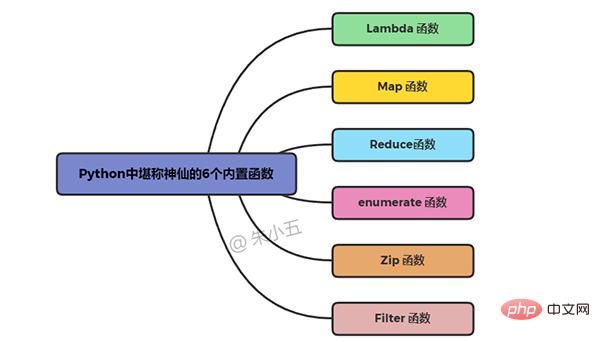
Lambda function
The Lambda function is used to create anonymous functions, that is, functions without names. It is just an expression, and the function body is much simpler than def. Anonymous functions are used when we need to create a function that performs a single operation and can be written in one line.
lambda [arg1 [,arg2,.....argn]]:expression
The body of lambda is an expression, not a code block. Only limited logic can be encapsulated in lambda expressions. For example:
lambda x: x+2
If we also want to call the function defined by def at any time, we can assign the lambda function to such a function object.
add2 = lambda x: x+2 add2(10)
Output result:

Using the Lambda function, the code can be simplified a lot. Here is another example.

As shown in the figure above, the result list newlist is generated with one line of code using the lambda function.
Map function
The map() function maps a function to all elements of an input list.
map(function,iterable)
For example, we first create a function to return an uppercase input word, and then apply this function to all elements in the list colors.
def makeupper(word): return word.upper() colors=['red','yellow','green','black'] colors_uppercase=list(map(makeupper,colors)) colors_uppercase
Output result:

In addition, we can also use anonymous function lambda to cooperate with the map function, which can be more streamlined.
colors=['red','yellow','green','black'] colors_uppercase=list(map(lambda x: x.upper(),colors)) colors_uppercase
If we don’t use the Map function, we need to use a for loop.
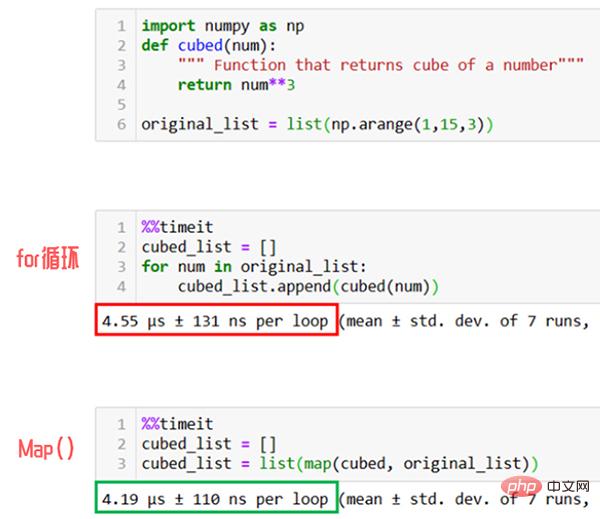
#As shown in the figure above, in actual use, the Map function will be 1.5 times faster than the for loop method of sequentially listing elements.
Reduce function
Reduce() is a very useful function when you need to perform some calculations on a list and return the result. For example, when you need to calculate the product of all elements of a list of integers, you can use the reduce function. [1]
The biggest difference between it and the function is that the mapping function (function) in reduce() receives two parameters, while map receives one parameter.
reduce(function, iterable[, initializer])
Next we use an example to demonstrate the code execution process of reduce().
from functools import reduce def add(x, y) : # 两数相加 return x + y numbers = [1,2,3,4,5] sum1 = reduce(add, numbers) # 计算列表和
The result sum1 = 15 is obtained, and the code execution process is shown in the animation below.

▲Code execution process animation
Combined with the above figure, we will see that reduce applies an addition function add() to a list[1 ,2,3,4,5], the mapping function receives two parameters, and reduce() continues to accumulate the result with the next element of the list.
In addition, we can also use anonymous function lambda to cooperate with the reduce function, which can be more streamlined.
from functools import reduce numbers = [1,2,3,4,5] sum2 = reduce(lambda x, y: x+y, numbers)
The output sum2= 15 is obtained, which is consistent with the previous result.
Note: reduce() has been moved to the functools module since Python 3.x [2]. If we want to use it, we need to import it from functools import reduce.
enumerate function
The enumerate() function is used to combine a traversable data object (such as a list, tuple or string) into an index sequence, while listing the data and data subscripts. It is generally used in for loops. Its syntax is as follows:
enumerate(iterable, start=0)
Its two parameters, one is a sequence, iterator or other object that supports iteration; the other is the starting position of the subscript, which starts from 0 by default, and can also be used since Defines the starting number of the counter.
colors = ['red', 'yellow', 'green', 'black'] result = enumerate(colors)
If we have a color list that stores colors, we will get an enumerate object after running it. It can be used directly in a for loop or converted to a list. The specific usage is as follows.
for count, element in result:
print(f"迭代编号:{count},对应元素:{element}")
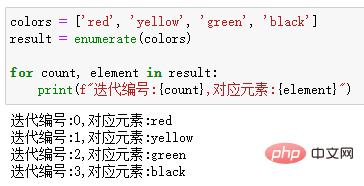
Zip 函数
zip()函数用于将可迭代的对象作为参数,将对象中对应的元素打包成一个个元组,然后返回由这些元组组成的列表[3]。
我们还是用两个列表作为例子演示:
colors = ['red', 'yellow', 'green', 'black'] fruits = ['apple', 'pineapple', 'grapes', 'cherry'] for item in zip(colors,fruits): print(item)
输出结果:
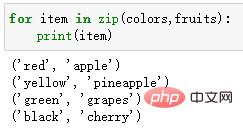
当我们使用zip()函数时,如果各个迭代器的元素个数不一致,则返回列表长度与最短的对象相同。
prices =[100,50,120] for item in zip(colors,fruits,prices): print(item)
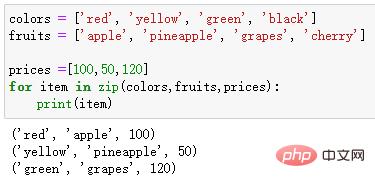
Filter 函数
filter()函数用于过滤序列,过滤掉不符合条件的元素,返回由符合条件元素组成的新列表,其语法如下所示[4]。
filter(function, iterable)
比如举个例子,我们可以先创建一个函数来检查单词是否为大写,然后使用filter()函数过滤出列表中的所有奇数:
def is_odd(n): return n % 2 == 1 old_list = [1, 2, 3, 4, 5, 6, 7, 8, 9, 10] new_list = filter(is_odd, old_list) print(newlist)
输出结果:

今天分享的这6个内置函数,在使用 Python 进行数据分析或者其他复杂的自动化任务时非常方便。
The above is the detailed content of Six magical built-in functions in Python. For more information, please follow other related articles on the PHP Chinese website!

Hot AI Tools

Undresser.AI Undress
AI-powered app for creating realistic nude photos

AI Clothes Remover
Online AI tool for removing clothes from photos.

Undress AI Tool
Undress images for free

Clothoff.io
AI clothes remover

AI Hentai Generator
Generate AI Hentai for free.

Hot Article

Hot Tools

Notepad++7.3.1
Easy-to-use and free code editor

SublimeText3 Chinese version
Chinese version, very easy to use

Zend Studio 13.0.1
Powerful PHP integrated development environment

Dreamweaver CS6
Visual web development tools

SublimeText3 Mac version
God-level code editing software (SublimeText3)

Hot Topics
 1376
1376
 52
52
 Do mysql need to pay
Apr 08, 2025 pm 05:36 PM
Do mysql need to pay
Apr 08, 2025 pm 05:36 PM
MySQL has a free community version and a paid enterprise version. The community version can be used and modified for free, but the support is limited and is suitable for applications with low stability requirements and strong technical capabilities. The Enterprise Edition provides comprehensive commercial support for applications that require a stable, reliable, high-performance database and willing to pay for support. Factors considered when choosing a version include application criticality, budgeting, and technical skills. There is no perfect option, only the most suitable option, and you need to choose carefully according to the specific situation.
 How to use mysql after installation
Apr 08, 2025 am 11:48 AM
How to use mysql after installation
Apr 08, 2025 am 11:48 AM
The article introduces the operation of MySQL database. First, you need to install a MySQL client, such as MySQLWorkbench or command line client. 1. Use the mysql-uroot-p command to connect to the server and log in with the root account password; 2. Use CREATEDATABASE to create a database, and USE select a database; 3. Use CREATETABLE to create a table, define fields and data types; 4. Use INSERTINTO to insert data, query data, update data by UPDATE, and delete data by DELETE. Only by mastering these steps, learning to deal with common problems and optimizing database performance can you use MySQL efficiently.
 MySQL download file is damaged and cannot be installed. Repair solution
Apr 08, 2025 am 11:21 AM
MySQL download file is damaged and cannot be installed. Repair solution
Apr 08, 2025 am 11:21 AM
MySQL download file is corrupt, what should I do? Alas, if you download MySQL, you can encounter file corruption. It’s really not easy these days! This article will talk about how to solve this problem so that everyone can avoid detours. After reading it, you can not only repair the damaged MySQL installation package, but also have a deeper understanding of the download and installation process to avoid getting stuck in the future. Let’s first talk about why downloading files is damaged. There are many reasons for this. Network problems are the culprit. Interruption in the download process and instability in the network may lead to file corruption. There is also the problem with the download source itself. The server file itself is broken, and of course it is also broken when you download it. In addition, excessive "passionate" scanning of some antivirus software may also cause file corruption. Diagnostic problem: Determine if the file is really corrupt
 MySQL can't be installed after downloading
Apr 08, 2025 am 11:24 AM
MySQL can't be installed after downloading
Apr 08, 2025 am 11:24 AM
The main reasons for MySQL installation failure are: 1. Permission issues, you need to run as an administrator or use the sudo command; 2. Dependencies are missing, and you need to install relevant development packages; 3. Port conflicts, you need to close the program that occupies port 3306 or modify the configuration file; 4. The installation package is corrupt, you need to download and verify the integrity; 5. The environment variable is incorrectly configured, and the environment variables must be correctly configured according to the operating system. Solve these problems and carefully check each step to successfully install MySQL.
 Solutions to the service that cannot be started after MySQL installation
Apr 08, 2025 am 11:18 AM
Solutions to the service that cannot be started after MySQL installation
Apr 08, 2025 am 11:18 AM
MySQL refused to start? Don’t panic, let’s check it out! Many friends found that the service could not be started after installing MySQL, and they were so anxious! Don’t worry, this article will take you to deal with it calmly and find out the mastermind behind it! After reading it, you can not only solve this problem, but also improve your understanding of MySQL services and your ideas for troubleshooting problems, and become a more powerful database administrator! The MySQL service failed to start, and there are many reasons, ranging from simple configuration errors to complex system problems. Let’s start with the most common aspects. Basic knowledge: A brief description of the service startup process MySQL service startup. Simply put, the operating system loads MySQL-related files and then starts the MySQL daemon. This involves configuration
 How to optimize database performance after mysql installation
Apr 08, 2025 am 11:36 AM
How to optimize database performance after mysql installation
Apr 08, 2025 am 11:36 AM
MySQL performance optimization needs to start from three aspects: installation configuration, indexing and query optimization, monitoring and tuning. 1. After installation, you need to adjust the my.cnf file according to the server configuration, such as the innodb_buffer_pool_size parameter, and close query_cache_size; 2. Create a suitable index to avoid excessive indexes, and optimize query statements, such as using the EXPLAIN command to analyze the execution plan; 3. Use MySQL's own monitoring tool (SHOWPROCESSLIST, SHOWSTATUS) to monitor the database health, and regularly back up and organize the database. Only by continuously optimizing these steps can the performance of MySQL database be improved.
 How to optimize MySQL performance for high-load applications?
Apr 08, 2025 pm 06:03 PM
How to optimize MySQL performance for high-load applications?
Apr 08, 2025 pm 06:03 PM
MySQL database performance optimization guide In resource-intensive applications, MySQL database plays a crucial role and is responsible for managing massive transactions. However, as the scale of application expands, database performance bottlenecks often become a constraint. This article will explore a series of effective MySQL performance optimization strategies to ensure that your application remains efficient and responsive under high loads. We will combine actual cases to explain in-depth key technologies such as indexing, query optimization, database design and caching. 1. Database architecture design and optimized database architecture is the cornerstone of MySQL performance optimization. Here are some core principles: Selecting the right data type and selecting the smallest data type that meets the needs can not only save storage space, but also improve data processing speed.
 Does mysql need the internet
Apr 08, 2025 pm 02:18 PM
Does mysql need the internet
Apr 08, 2025 pm 02:18 PM
MySQL can run without network connections for basic data storage and management. However, network connection is required for interaction with other systems, remote access, or using advanced features such as replication and clustering. Additionally, security measures (such as firewalls), performance optimization (choose the right network connection), and data backup are critical to connecting to the Internet.




